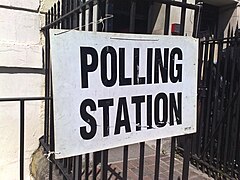 A polling station in Camberwell, London on 6 May 2010. | |
| Date | 7 May 2010 – 12 May 2010 |
|---|---|
| Location | London, England, United Kingdom |
| Cause | Hung parliament following the 2010 general election |
| Participants | |
| Outcome | |
The events surrounding the formation of the United Kingdom's government in 2010 took place between 7 May and 12 May 2010, following the 2010 general election, which failed to produce an overall majority for either of the country's two main political parties. The election, held on 6 May, resulted in the first hung parliament in the UK in 36 years, sparking a series of negotiations which would form the first coalition government since the Second World War.
The governing Labour administration led by Gordon Brown was defeated in the election and lost its overall majority after 13 years in office, but continued in office in an acting capacity until a government could be formed. The opposition Conservative Party led by David Cameron won the largest number of seats in the new Parliament, but fell short of the number required to secure an overall majority. Consequently, senior figures from both parties embarked on a series of meetings with representatives from the Liberal Democrats led by Nick Clegg, aimed at forming a coalition government.
As leader of the third largest party, Clegg had announced that the Liberal Democrats would enter talks with whichever party held the greater number of seats. A series of meetings with the Conservatives began shortly after the hung parliament was announced, and continued over the weekend after the election. Negotiations were also held with the Labour Party. The Scottish National Party signalled its willingness to join Labour and the Liberal Democrats and other minor parties in government as part of a progressive rainbow coalition, but it quickly became clear that Gordon Brown's continued presence as Prime Minister was seen as a major obstacle to formulating a Labour–Liberal Democrat deal.
Although Brown relinquished his role as Labour leader on 10 May, the party failed to reach an agreement with the Liberal Democrats; the latter instead struck a deal with the Conservatives the following day. Brown resigned as Prime Minister and Labour Leader on the evening of 11 May, and the Conservative–Liberal Democrat coalition government led by David Cameron took office shortly thereafter. The Liberal Democrats emerged from a meeting of their Parliamentary party and Federal Executive to announce that the coalition deal had been "approved overwhelmingly" shortly after midnight on 12 May, and later the same day the two parties published the Conservative–Liberal Democrat coalition agreement setting out the terms of their deal. While Cameron became Prime Minister, Liberal Democrat leader Nick Clegg was appointed as Deputy Prime Minister.
© MMXXIII Rich X Search. We shall prevail. All rights reserved. Rich X Search
